Table of Contents
So, Why Are We Not Growing Teeth On Demand Already?
There are still a lot of challenges that need to be overcome before this dream of growing teeth on demand becomes a reality. Even though scientists now know each and every component that plays a part in the process, they do not know which molecule is required in what quantity and at what time.
Another problem is that the stem cells that are needed for the entire process are found in small quantities, most often from the third molars (wisdom teeth), and may have a limited potential to develop into teeth. The next big hurdle is that of time. Normal tooth formation takes around five years. Not everyone would be willing to wait for that long to have their replacement form and erupt. Scientists have to find out a way to reduce this entire process to something more in line with the treatment modalities that exist today. Even an implant placement, for example can frequently take around six to eight months to fully integrate with the body, particularly if grafting is done alongside.

Even if all these problems were to be solved, scientists still do not know what are the triggers needed to dictate the type of teeth that are being formed. All the teeth, from the ones in the front to the chewing ones in the back start out in the same manner and then start to differentiate only in the later stages of tooth development. This knowledge is essential from the point of dispensing clinical treatment. After all, the end result has to be a tooth of appropriate size and shape to really serve the functions needed.
READ Fixed Prosthesis: Should You Get Permanent Dentures? (Hint: Yes!)
Why Do We Even Want To Try?
Current methods to replace missing teeth have made tremendous advances in terms of strength, durability and even becoming cost affordable, however none of the treatment modalities are able to integrate with the existing structures. They into co-exist around it, never really becoming a part of the body. This means that the patient does not have the same satisfaction while eating since there are no neural connections.
The challenges that lie ahead of the researchers are many and there more than a couple of people who consider them insurmountable, however there is no douhbt that the goal is worthy of a long and sustained effort. The next time you come across a headline claiming how scientists will be able to grow new teeth in the lab soon, know that while that time has not yet arrived, it is not unthinkable that it will arrive within our life spans.
- Photo courtesy of Mike Burns: www.flickr.com/photos/mike-burns/1155974383
- Photo courtesy of sandervds123 https://www.flickr.com/photos/sandervds/3483682854/sizes/z/
- 1. Tissue engineering in dentistry.Journal of Dentistry Volume 2, Issue 8, August 2014, Pages 915–928.
- 2. Tissue engineering and its implications in dentistry. Indian Journal Of Dental Research. Parimala Tyagi. 2009. Vol20, Issue 2, Pg 222-226


Your thoughts on this